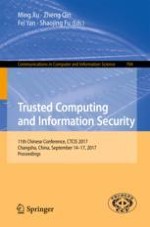This book constitutes the refereed proceedings of the 11th Chinese Conference on Trusted Computing and Information Security, CTCIS 2017, held in Changsha, China, in September 2017.
The 28 revised full papers presented were carefully reviewed and selected from 96 submissions. The papers focus on topics such as theory of trusted computing, trustworthy software; infrastructure of trusted computing, application and evaluation of trusted computing; network security and communication security; theory and technology of cryptographic techniques; information content security; system security for mobile network and IoT systems, industrial control and embedded systems; security for Cloud computing, virtualization systems and big data.

